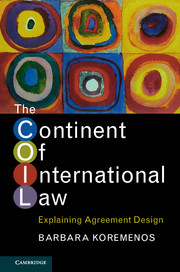Book contents
- Frontmatter
- Dedication
- Contents
- List of figures
- List of tables
- Acknowledgments
- 1 (Re)discovering the continent
- Part I COIL's building blocks: theory and data
- Part II Flexibility provisions in the design of international law
- Part III Centralization, scope, and control provisions in the design of international law
- 7 Dispute resolution provisions
- 8 Punishment provisions
- 9 Monitoring provisions
- 10 Asymmetric design rules, voting, and power
- 11 Conclusion
- Appendix 1 List of agreements in COIL sample
- Appendix 2 Coding rules
- Appendix 3 Selection issues in international cooperation data sets
- References
- Index
10 - Asymmetric design rules, voting, and power
from Part III - Centralization, scope, and control provisions in the design of international law
Published online by Cambridge University Press: 05 June 2016
- Frontmatter
- Dedication
- Contents
- List of figures
- List of tables
- Acknowledgments
- 1 (Re)discovering the continent
- Part I COIL's building blocks: theory and data
- Part II Flexibility provisions in the design of international law
- Part III Centralization, scope, and control provisions in the design of international law
- 7 Dispute resolution provisions
- 8 Punishment provisions
- 9 Monitoring provisions
- 10 Asymmetric design rules, voting, and power
- 11 Conclusion
- Appendix 1 List of agreements in COIL sample
- Appendix 2 Coding rules
- Appendix 3 Selection issues in international cooperation data sets
- References
- Index
Summary
[The realists] believed instead in the polarity of law and power, opposing one to the other as the respective emblems of the domestic versus the international realm, normative aspiration versus positive description, cooperation versus conflict …
(Slaughter Burley 1993: 207)[T]he international legal system also seems to distance itself from predominant power: based on sovereign equality, it is disinclined to grant formal recognition to structures of superiority and leaves them to the political realm.
(Krisch 2005: 370)Extreme positions are not succeeded by moderate ones but by extreme positions of the opposite kind.
(Nietzsche [1887] 1967: 35)Do formal voting rules and other aspects of agreement design reflect or ignore the realities of power? In this chapter, I examine whether the conjecture Asymmetry of Power is reflected in Asymmetry of Control is supported by the COIL data. If power is at least somewhat reflected in the provisions of international law, Krisch's depiction of the relationship between law and power seems questionable. At the same time, if the provisions of international law correspond always and exactly to the configuration of power, one cannot plausibly argue that law has any kind of constraining effect on powerful states. Of course, at least one other possibility remains: As mentioned in Chapter 8, Stone (2011) and Cogan (2009) argue that the Power Asymmetries inherent in many cooperative endeavors most likely manifest informally, while formal law represents a consensus among all state parties. Thus looking at the degree to which the hypothesis about Asymmetry of Power is or is not supported by the data might also give us a sense of whether and how often formal and informal provisions might conflict.
In what follows, I begin by presenting the (moderate) view of this book: Agreement design neither completely reflects nor completely ignores the realities of power. I then present some descriptive statistics about how often the provisions of the agreements in the COIL sample reflect the underlying distribution of power. I probe the conjecture regarding power and institutional design with the data to see how well it is supported. I then present three case studies (using agreements from the sample) that illustrate some of the themes of this chapter and generate some interesting questions for future research.
- Type
- Chapter
- Information
- The Continent of International LawExplaining Agreement Design, pp. 293 - 319Publisher: Cambridge University PressPrint publication year: 2016



